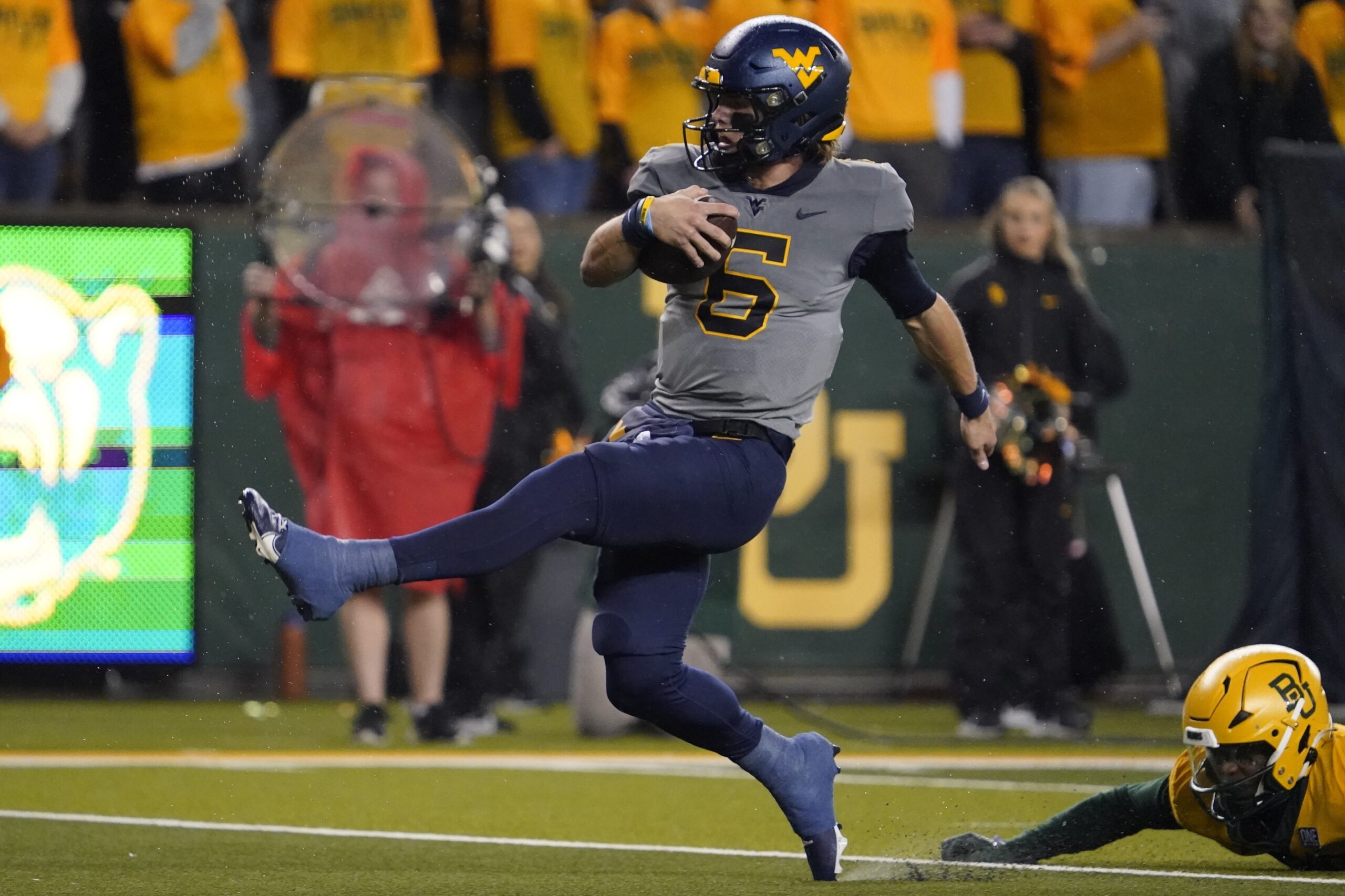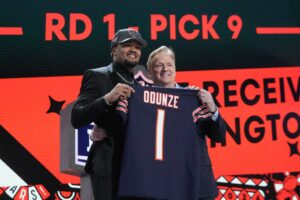In the regular season finale, West Virginia required all 60 minutes to overcome Baylor’s special teams and second-half onslaught. Ultimately, the Mountaineers prevailed 34-31. On the day after, we want to take a look at five numbers from West Virginia’s win over Baylor.
Five Numbers from West Virginia’s Win Over Baylor
Some of these numbers are less important to this game than others. We use some of them as a platform to say what we need to say about where head coach Neal Brown should focus his off-season efforts to improve upon the Mountaineers’ surprise 8-4 showing this season.
The Number 14
The first number to discuss is also the most obvious: the number 14. The media at 247Sports predicted the West Virginia Mountaineers to finish fourteenth in the Big 12 this year. They actually finished tied for fourth. Indeed, WVU was a Hail Mary short of finishing the season tied for second in the conference, though they would have lost the tiebreaker for the conference championship game. That is a big jump. We can say what we want about the Mountaineers’ strength of schedule. They won three games against teams that finished in the bottom four of the conference. They won two more against the teams that round out the bottom half. Their out-of-conference win came over Duquesne and Pitt, the latter of whom finished 3-9, good for 11th in the ACC.
Things were not supposed to be that easy, of course. The Panthers finished last season 9-4 and ranked 20th in the final AP poll. TCU represented the college football playoff’s runner-up. The Big 12 newcomers were supposed to be better than they were. The predicted results simply did not play out. On the other hand, the schedule was what it was, and West Virginia did okay with it. They had a chance to do even better. Barring a superhuman effort by Ollie Gordon in the fourth quarter, the Mountaineers have a boxer’s chance against Oklahoma State. Then, there was the Hail Mary against Houston. Turning a prediction to finish 14th into a fourth-place finish still isn’t a bad thing.
250
The Mountaineers ran for 250 yards against Baylor, and it marks the fifth time they met or exceeded that total this season. Now, it was not that long ago that Brown had just arrived in Morgantown and pronounced that he sought to establish a run-first identity. He lamented the state of the offensive line upon his arrival and promised to rebuild it. While there are aspects of the game that require plenty of work, we can safely say he met that challenge head-on. Indeed, the Mountaineers have established a ground-and-pound offensive identity.
In his first season in Morgantown, Brown’s Mountaineers failed miserably running the football. They averaged 73 yards of rushing offense per game with an atrocious two-and-a-half yards per carry. They improved incrementally since, and, this season, the Mountaineers simply smashed all expectations. WVU averaged a whopping 234 yards on the ground per game, good enough for third in the country, and tops among Power Five schools. WVU also averaged nearly five-and-a-half yards per carry. Yes, they ran often, but they also ran efficiently.
West Virginia amassed those 250 yards against Baylor through efforts by Jahiem White (133 yards on 17 carries), Garrett Greene (103 yards on 14 carries), and CJ Donaldson (23 yards on 5 carries). White finishes his regular season playing in just nine games with 792 yards on 97 carries, good for over eight per carry. Donaldson tallied 798 yards on 171 carries while dealing with lingering injury issues. Greene added 708 yards on 111 carries. Barring anything unforeseen, West Virginia should return quite the three-headed monster for 2024.
The Number Two
In many ways, West Virginia’s win over Baylor included late-game heroics that simply should not have been required. Going into halftime, the Mountaineers outscored Baylor’s offense 27-0. That is where the number two comes into play. In the second quarter, Baylor scored fourteen points on two kickoff returns for touchdowns, both by Richard Reese. He accounted for 237 total yards on kickoff returns on Saturday night. Meanwhile, Reese amassed just 45 total yards on offense otherwise. Worse still, Reese returned those kicks on back-to-back plays to keep West Virginia from building an insurmountable lead.
Oddly, when we first talked about the Mountaineers’ special teams this season, we talked about them because they helped the Mountaineers beat TCU by blocking two field goals in the final five minutes to secure a 24-21 win. Throughout the season, however, the special teams proved to be a liability more often. Against Oklahoma State, Andrew Wilson-Lamp collided with Preston Fox while he was fielding a punt. The collision caused a fumble that was recovered by Oklahoma State.
This undoubtedly turned the tide of the game, flipping what could have been a 31-20 Mountaineer lead to a 27-24 Oklahoma State lead early in the fourth quarter. The game before, West Virginia surrendered a kick return touchdown by Houston early in the game. On Saturday night, those two kick return touchdowns kept the game within reach and gave Baylor enough to come out of the locker room swinging in the second half.
54
Speaking of late-game heroics, perhaps no player gave more of himself to secure West Virginia’s win over Baylor than WVU’s own Zach Frazier. On the first play of West Virginia’s final drive to score the go-ahead touchdown, Frazier physically carried Hudson Clement to a first down that stopped the clock. Frazier was hurt on the play, and, instead of going down in pain, he hobbled on one leg to the sideline to avoid the ten-second run-off that would have happened had he gone down on the field. Instead, he waited until he was out of bounds to fall down in the clear agony he felt.
Blue collar is the word we use most often to describe the true nature of a Mountaineer. Frazier showed that. In an era where players routinely sit out bowl games, final games, and sometimes whole seasons to preserve their personal goals, Frazier sacrificed himself to help the team win. That he had the presence of mind to do so also speaks to Frazier’s awareness and intelligence. What was the cost? Brown described the injury as one that will not be long-term but that it is significant enough to keep Frazier out of the bowl game. This likely means Frazier won’t be able to partake in Senior Bowl festivities, and that could have at least some impact on his draft stock.
This moment represents a microcosm of Frazier’s tenure as the starting center in Morgantown. The number 54, as a result, deserves his own section when talking about this game.
The Number Zero
The final number we want to discuss is the number zero. Look, Mountaineer fans and media have been rightfully critical of Coach Brown’s clock management during his tenure. We lost count long ago of the number of time-outs Brown burned because a play was not called in quickly enough. Once, he even had to burn a time-out on an opening kick-off in the second half to avoid a delay of game penalty. This season, though, that result has happened sparingly, and, with just a single exception we can recall, Brown used his timeouts at pivotal moments to the outcome of games.
Thus, we look at the number zero. This represents the number of timeouts Brown burned unnecessarily in the Baylor game. Had he used any timeouts early in the half, as he had too often in past years, Baylor let the clock expire and won this game. That he had all three in his pocket allowed West Virginia to preserve enough clock to get the ball back with just over a minute left in the game. While his team had to execute to capitalize on the opportunity, they would not in that position had Brown not evolved in his ability to manage the clock. Whatever else we have to say critical of Brown, this is but one way Brown has evolved for the better over the course of his tenure in Morgantown.







